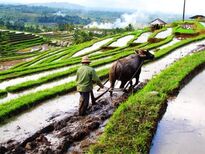Tri Hita Karana is a traditional philosophy for life on the island of
Bali, which literally means the three causes of wellbeing and
prosperity, namely, harmony with God, with people and with nature and
the environment. The principles of this philosophy guide the life of
the Balinese people, who dedicate rituals to honour gods, nature and
harmony in the universe. Therefore, you see offerings all around Bali,
not only at every temple, but also outside each shop, house, on cars,
scooters, under the trees, near water bodies and more. All is so
revered, and all is seen and treated as sacred. This principle is also
reflected in the rice plantation management.
One of the most important parts of a successful rice plantation is of
course the land and the rice, but it all starts with the water. The
Subak irrigation system has been in use for over 1,000 years. This
consists of canals and spirals that bring the natural spring water
into the water temples and from there making it flow into the rice
plantations. That is where it all starts, with a reunion of the
community in the local Subak to decide and plan how the water is going
to be distributed amongst the plantations. Once this stage is agreed
and the fields get water, the farmers perform an offering (Banten) and
then proceed with ploughing the land to then give it a rest for a
couple of weeks. At this stage is when the ceremony called Ngerasakin
takes place – this is an offering to Mother Earth (in Bali called
Prtivi ) पृतिवी. A red thread is used and this is to ask permission,
gratefulness and to show how we don’t take anything for granted from
mother nature. The farmers hope for a nice harvest and pray to be in
sync with nature, not to encounter obstacles, have the correct amount
of water, enough sun and all that’s needed for a smooth and successful
rice harvest in the months to come.

When it’s time to start planting, the farmers first grow rice in
one of the corners of the rice field (sawa) and this is what can
be called the sprouting process. Once you can see the rice plant
coming up , the offerings shift to Devi Sri श्री, who is the
Goddess of Rice.
The offering you see in the picture is called Rasaka, or Pijate.
This offering brings together many symbols of the cosmos and of
how it all comes together: it wants to show how we are in
harmony with nature and the gods, and how us humans are in
between. The offering is to pray for all the forces of nature to
be in balance. Life in general is full of challenges and there
are also some obstacles along the way, as well as smooth times.
In this occasion farmers, like much so in Vaidika lifestructure,
pray to be objective and to always be able to see the bigger
picture and not get stuck with the small things when some
challenges come up in the process. This is how we can keep in
balance within ourselves, amongst other humans and in relation
to nature and the whole universe.

When it’s time to start planting, the farmers first grow rice in
one of the corners of the rice field (sawa) and this is what can
be called the sprouting process. Once you can see the rice plant
coming up 🌾, the offerings shift to Devi Sri श्री, who is the
Goddess of Rice.
The offering you see in the picture is called Rasaka, or Pijate.
This offering brings together many symbols of the cosmos and of
how it all comes together: it wants to show how we are in
harmony with nature and the gods, and how us humans are in
between.